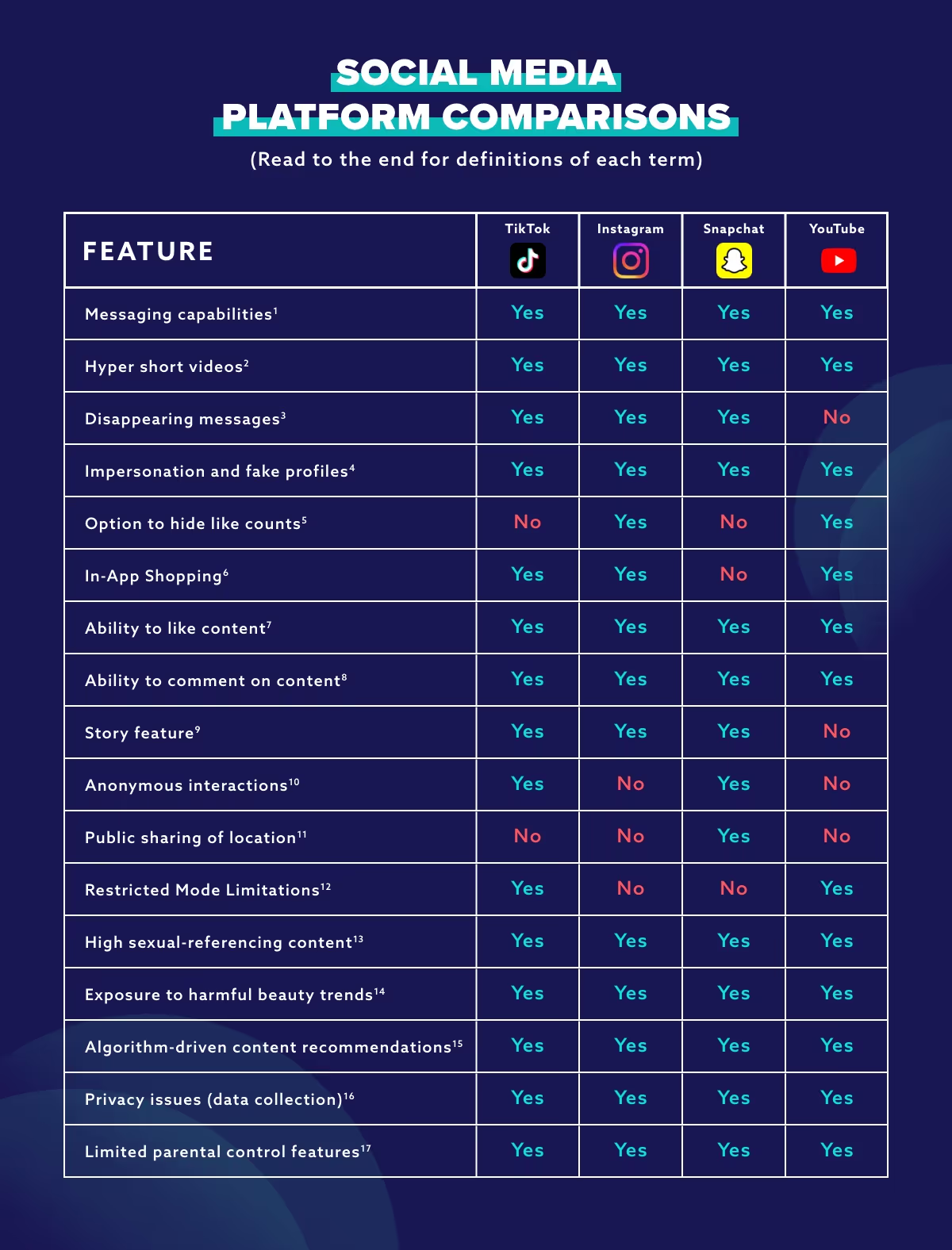


Many social media apps now look and feel nearly identical because companies quickly copy each other’s features. Disappearing messages, short videos, in-app shopping, anonymous interactions, and algorithm-driven feeds are now common across TikTok, Instagram, YouTube, and Snapchat, making the risks and pressures similar on all of them. A comparison chart can help families see how these features shape teens’ experiences and why conversations about safety, privacy, and attention are so important.
It has been interesting and not the least bit surprising that social media apps have become far more similar than different.
It makes perfect sense since companies see what young people use on other apps and incorporate such features into their own apps.
For example, we think of Snapchat and its hallmark disappearing messages, but did you know that TikTok and Instagram have incorporated this feature as an option into their apps?
Did you know that in-app shopping is central not just to Instagram but also to TikTok and YouTube?
We have created a table that compares the 4 most common social media platforms and the specific ways they are similar and different (spoiler alert, they are way more similar than different).
Be sure to scroll down beyond the graph to read the definitions of the terms at the bottom of the graph, like the “Option to hide Like Counts” or “Impersonation” and “Fake profiles.”
So contact any youth in your life and discuss this graph with them. This is yet another unique way to address the seminal topic of social media and highlight ways that companies do all they can to get our attention.
Learn more about showing our movies in your school or community!
Join Screenagers filmmaker Delaney Ruston MD for our latest Podcast

Learn more about our Screen-Free Sleep campaign at the website!
Our movie made for parents and educators of younger kids
Learn more about showing our movies in your school or community!

1. Messaging capabilities: All platforms offer direct messaging features, enabling private communication between users.
2. Hyper-short videos: All platforms now support short-form video content, a format initially from TikTok.
3. Disappearing messages: Features like disappearing messages on Snapchat, Instagram, and TikTok's direct messages make it difficult for parents to monitor communication. Yes, TikTok and Instagram have a feature to turn on to make messages disappear.
4. Impersonation and fake profiles: Teens can be targeted by individuals using fake profiles, leading to potential risks such as catfishing, scams, or privacy violations.
5. Option to hide like counts: Instagram and YouTube allow users to hide like counts on their content. The user hiding their like counts can still see the number of likes, but viewers cannot.
6. In-App Shopping: TikTok, Instagram, and YouTube support in-app shopping features, enabling users to purchase products directly from the platform. Teens can spend money on virtual goods without realizing the financial impact.
7. Ability to like content: Liking content is a standard feature across all platforms.
8. Ability to comment on content: Users can comment on videos and posts across all platforms
9. Story feature: Temporary posts that disappear after a set period are available on TikTok, Instagram, and Snapchat.
10. Anonymous interactions: Anonymous features (like TikTok's Q&A or Snapchat's anonymous messages) can lead to negative interactions without accountability.
11. Public sharing of location: Snap Map allows users to share their real-time location publicly with friends by pinning their Bitmoji on a map. While this feature can be useful for meeting up with friends, it also means that anyone with access to the map can see where the user is located at any given moment.
12. Restricted Mode Limitations: Restricted Mode is a feature designed to limit exposure to content that may not be suitable for everyone, such as content with mature or complex themes. While it can help protect teens from inappropriate material, it also has limitations and can restrict access to certain features. Some content may be filtered out on TikTok to avoid exposure to mature themes. However, certain features like the Following feed and gifting on LIVE are unavailable. On YouTube, it helps filter out potentially mature content. However, it can also limit access to some videos and features, making it harder for teens to engage with a broad range of content.
13. High sexual referencing content: Each platform has content that can be sexual or suggestive, although this varies by user and content creator.
14. Exposure to harmful beauty trends: Teens are often exposed to beauty trends that promote unrealistic or harmful standards.
15. Algorithm-driven content recommendation: Algorithms personalize content feeds to keep users engaged.
16. Privacy issues (data collection): Each platform collects user data, reducing user privacy and data security.
17. Limited parental control features: Platforms have limited options for parents to monitor or control their teen's activities, making it harder to ensure safe usage.
Learn more about showing our movies in your school or community!
Join Screenagers filmmaker Delaney Ruston MD for our latest Podcast

Learn more about our Screen-Free Sleep campaign at the website!
Our movie made for parents and educators of younger kids
Join Screenagers filmmaker Delaney Ruston MD for our latest Podcast
Be sure to subscribe to our YouTube Channel! With new ones added regularly, you'll find over 100 videos covering parenting advice, guidance, podcasts, movie clips and more. Here's our latest!
As we’re about to celebrate 10 years of Screenagers, we want to hear what’s been most helpful and what you’d like to see next.
Please click here to share your thoughts with us in our community survey. It only takes 5–10 minutes, and everyone who completes it will be entered to win one of five $50 Amazon vouchers.
It has been interesting and not the least bit surprising that social media apps have become far more similar than different.
It makes perfect sense since companies see what young people use on other apps and incorporate such features into their own apps.
For example, we think of Snapchat and its hallmark disappearing messages, but did you know that TikTok and Instagram have incorporated this feature as an option into their apps?
Did you know that in-app shopping is central not just to Instagram but also to TikTok and YouTube?
We have created a table that compares the 4 most common social media platforms and the specific ways they are similar and different (spoiler alert, they are way more similar than different).
Be sure to scroll down beyond the graph to read the definitions of the terms at the bottom of the graph, like the “Option to hide Like Counts” or “Impersonation” and “Fake profiles.”
So contact any youth in your life and discuss this graph with them. This is yet another unique way to address the seminal topic of social media and highlight ways that companies do all they can to get our attention.

1. Messaging capabilities: All platforms offer direct messaging features, enabling private communication between users.
2. Hyper-short videos: All platforms now support short-form video content, a format initially from TikTok.
3. Disappearing messages: Features like disappearing messages on Snapchat, Instagram, and TikTok's direct messages make it difficult for parents to monitor communication. Yes, TikTok and Instagram have a feature to turn on to make messages disappear.
4. Impersonation and fake profiles: Teens can be targeted by individuals using fake profiles, leading to potential risks such as catfishing, scams, or privacy violations.
5. Option to hide like counts: Instagram and YouTube allow users to hide like counts on their content. The user hiding their like counts can still see the number of likes, but viewers cannot.
6. In-App Shopping: TikTok, Instagram, and YouTube support in-app shopping features, enabling users to purchase products directly from the platform. Teens can spend money on virtual goods without realizing the financial impact.
7. Ability to like content: Liking content is a standard feature across all platforms.
8. Ability to comment on content: Users can comment on videos and posts across all platforms
9. Story feature: Temporary posts that disappear after a set period are available on TikTok, Instagram, and Snapchat.
10. Anonymous interactions: Anonymous features (like TikTok's Q&A or Snapchat's anonymous messages) can lead to negative interactions without accountability.
11. Public sharing of location: Snap Map allows users to share their real-time location publicly with friends by pinning their Bitmoji on a map. While this feature can be useful for meeting up with friends, it also means that anyone with access to the map can see where the user is located at any given moment.
12. Restricted Mode Limitations: Restricted Mode is a feature designed to limit exposure to content that may not be suitable for everyone, such as content with mature or complex themes. While it can help protect teens from inappropriate material, it also has limitations and can restrict access to certain features. Some content may be filtered out on TikTok to avoid exposure to mature themes. However, certain features like the Following feed and gifting on LIVE are unavailable. On YouTube, it helps filter out potentially mature content. However, it can also limit access to some videos and features, making it harder for teens to engage with a broad range of content.
13. High sexual referencing content: Each platform has content that can be sexual or suggestive, although this varies by user and content creator.
14. Exposure to harmful beauty trends: Teens are often exposed to beauty trends that promote unrealistic or harmful standards.
15. Algorithm-driven content recommendation: Algorithms personalize content feeds to keep users engaged.
16. Privacy issues (data collection): Each platform collects user data, reducing user privacy and data security.
17. Limited parental control features: Platforms have limited options for parents to monitor or control their teen's activities, making it harder to ensure safe usage.
Be sure to subscribe to our YouTube Channel! With new ones added regularly, you'll find over 100 videos covering parenting advice, guidance, podcasts, movie clips and more. Here's our latest!
Sign up here to receive the weekly Tech Talk Tuesdays newsletter from Screenagers filmmaker Delaney Ruston MD.
We respect your privacy.
It has been interesting and not the least bit surprising that social media apps have become far more similar than different.
It makes perfect sense since companies see what young people use on other apps and incorporate such features into their own apps.
For example, we think of Snapchat and its hallmark disappearing messages, but did you know that TikTok and Instagram have incorporated this feature as an option into their apps?
Did you know that in-app shopping is central not just to Instagram but also to TikTok and YouTube?
We have created a table that compares the 4 most common social media platforms and the specific ways they are similar and different (spoiler alert, they are way more similar than different).
Be sure to scroll down beyond the graph to read the definitions of the terms at the bottom of the graph, like the “Option to hide Like Counts” or “Impersonation” and “Fake profiles.”
So contact any youth in your life and discuss this graph with them. This is yet another unique way to address the seminal topic of social media and highlight ways that companies do all they can to get our attention.

It feels like we’re finally hitting a tipping point. The harms from social media in young people’s lives have been building for far too long, and bold solutions can’t wait any longer. That’s why what just happened in Australia is extremely exciting. Their new nationwide move marks one of the biggest attempts yet to protect kids online. And as we released a new podcast episode yesterday featuring a mother who lost her 14-year-old son after a tragic connection made through social media, I couldn’t help but think: this is exactly the kind of real-world action families have been desperate for. In today’s blog, I share five key things to understand about what Australia is doing because it’s big, it’s controversial, and it might just spark global change.
READ MORE >
I hear from so many parents who feel conflicted about their own phone habits when it comes to modeling healthy use for their kids. They’ll say, “I tell my kids to get off their screens, but then I’m on mine all the time.” Today I introduce two moms who are taking on my One Small Change Challenge and share how you can try it too.
READ MORE >
This week’s blog explores how influencers and social media promoting so-called “Healthy” ideals — from food rules to fitness fads — can quietly lead young people toward disordered eating. Featuring insights from Dr. Jennifer Gaudiani, a leading expert on eating disorders, we unpack how to spot harmful messages and start honest conversations with kids about wellness, body image, and what “healthy” really means.
READ MORE >for more like this, DR. DELANEY RUSTON'S NEW BOOK, PARENTING IN THE SCREEN AGE, IS THE DEFINITIVE GUIDE FOR TODAY’S PARENTS. WITH INSIGHTS ON SCREEN TIME FROM RESEARCHERS, INPUT FROM KIDS & TEENS, THIS BOOK IS PACKED WITH SOLUTIONS FOR HOW TO START AND SUSTAIN PRODUCTIVE FAMILY TALKS ABOUT TECHNOLOGY AND IT’S IMPACT ON OUR MENTAL WELLBEING.
